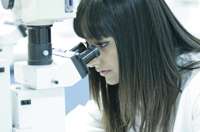Combining imaging and gene analysis could transform breast cancer diagnosis

Combining two approaches - one that digitally scans images of tumour samples and another that analyses genetic information - gives a more accurate prediction of how breast cancer will behave. The research is published today in Science Translational Medicine.
Researchers at the Cancer Research UK Cambridge Research Institute have built a computer system that automatically analyses microscopy images of hundreds of breast cancer samples. The new approach looks at the makeup of the cells within a tumour, normally undertaken by a pathologist looking down a microscope, and combines these images with the key genetic changes that are crucial for the development of breast cancer.
Compared to carrying out these tests individually, the new system was more accurate and could give researchers more detailed information about a woman's breast cancer.
Survival from a type of breast cancer called oestrogen receptor negative can be predicted by the number of white blood immune cells that have entered the tumour. The new test increased the accuracy of predictions based on this from 67 to 86 per cent.
The researchers also found a new way to predict survival based on the arrangement of supporting cells within the cancer. Known as the stroma, these cells play a role in encouraging the growth of breast cancers and are not detected in current tests.
Dr Florian Markowetz, the lead researcher at Cancer Research UK's Cambridge Research Institute, said: "Cancers are a mix of different cells – not just cancer cells – they also include those from the immune system and others that support the structure of the tumour. These cells play an important role in how cancers behave, but this information is not currently detected in tests that focus on the genetic makeup of the cancer.
"By bridging the gap between the 'two cultures' of pathology and genomics our research has a huge potential for better understanding breast cancer."
Professor Carlos Caldas, also based at Cancer Research UK's Cambridge Research Institute, said: "This research complements our study earlier this year that found breast cancer was in fact at least ten different diseases. This now takes us a step closer to being able to use this knowledge in the clinic and directly benefit women with breast cancer."
Dr Julie Sharp, senior science information manager at Cancer Research UK, said: "Combining the visual information from a breast tumour with knowledge of its genetic makeup using computer systems could have a profound impact on how cancer clinics of the future work, enabling doctors to offer women treatments that are tailored to their individual breast cancer."
More information: Yuan, Y et al Quantitative image analysis of cellular heterogeneity in breast tumors complements genomic profiling (2012) Science Translational Medicine.













